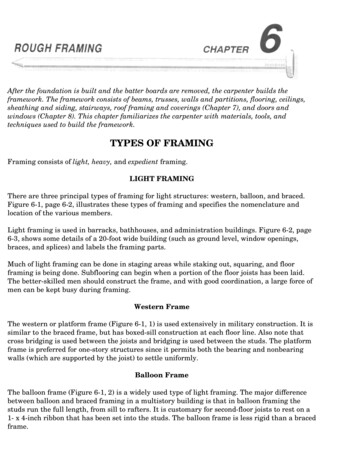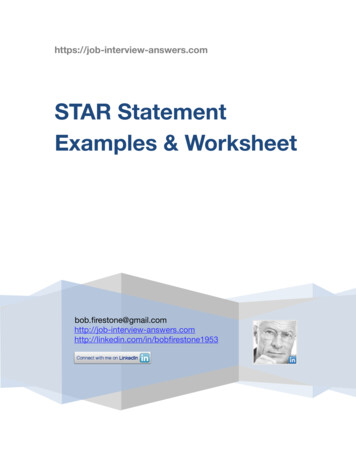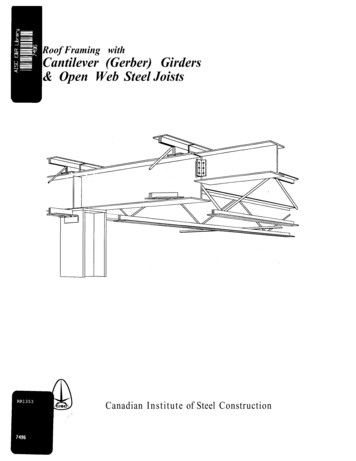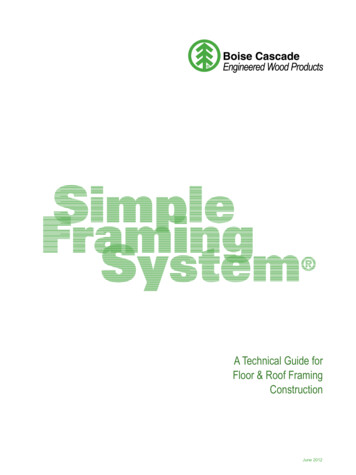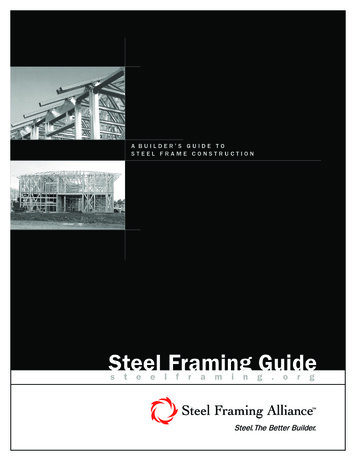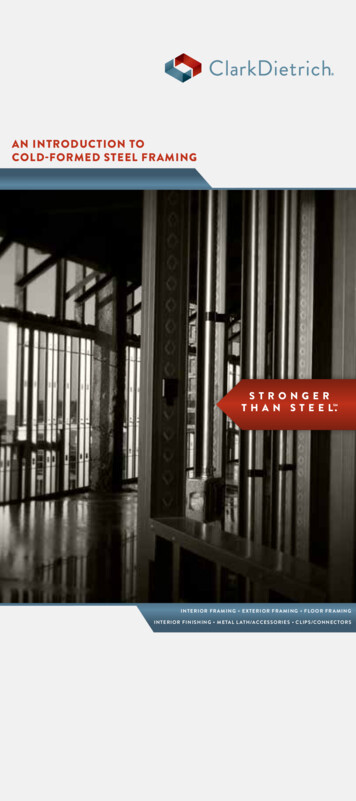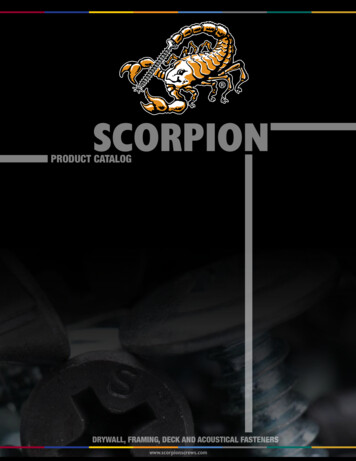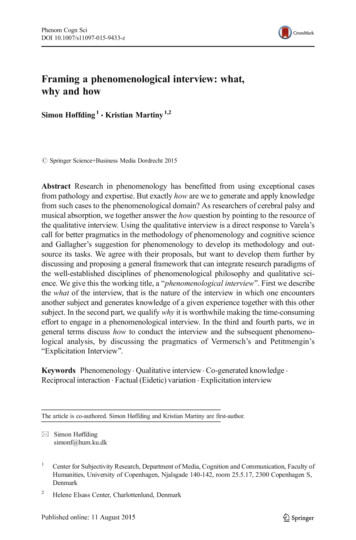
Transcription
Phenom Cogn SciDOI 10.1007/s11097-015-9433-zFraming a phenomenological interview: what,why and howSimon Høffding 1 & Kristian Martiny 1,2# Springer Science Business Media Dordrecht 2015Abstract Research in phenomenology has benefitted from using exceptional casesfrom pathology and expertise. But exactly how are we to generate and apply knowledgefrom such cases to the phenomenological domain? As researchers of cerebral palsy andmusical absorption, we together answer the how question by pointing to the resource ofthe qualitative interview. Using the qualitative interview is a direct response to Varela’scall for better pragmatics in the methodology of phenomenology and cognitive scienceand Gallagher’s suggestion for phenomenology to develop its methodology and outsource its tasks. We agree with their proposals, but want to develop them further bydiscussing and proposing a general framework that can integrate research paradigms ofthe well-established disciplines of phenomenological philosophy and qualitative science. We give this the working title, a Bphenomenological interview . First we describethe what of the interview, that is the nature of the interview in which one encountersanother subject and generates knowledge of a given experience together with this othersubject. In the second part, we qualify why it is worthwhile making the time-consumingeffort to engage in a phenomenological interview. In the third and fourth parts, we ingeneral terms discuss how to conduct the interview and the subsequent phenomenological analysis, by discussing the pragmatics of Vermersch’s and Petitmengin’sBExplicitation Interview .Keywords Phenomenology . Qualitative interview . Co-generated knowledge .Reciprocal interaction . Factual (Eidetic) variation . Explicitation interviewThe article is co-authored. Simon Høffding and Kristian Martiny are first-author.* Simon Høffdingsimonf@hum.ku.dk1Center for Subjectivity Research, Department of Media, Cognition and Communication, Faculty ofHumanities, University of Copenhagen, Njalsgade 140-142, room 25.5.17, 2300 Copenhagen S,Denmark2Helene Elsass Center, Charlottenlund, Denmark
S. Høffding, K. Martiny1 IntroductionResearch in phenomenology has benefitted from using exceptional cases from pathology and expertise. But exactly how are we to generate and apply knowledge from suchcases to the phenomenological domain? For example, an investigation into the condition of Cerebral Palsy (CP) might expose challenges to our normal assumptions aboutwhat it means to have a sense of control over one’s body. However, if you want tounderstand the lived experience of someone with CP, how would you do that?Furthermore, as seen from the McDowell-Dreyfus debate (see Schear 2013), examplesfrom bodily expertise can be used in parallel with pathology. Such an examinationmight reveal something fundamental about our ability to reflect and act at the sametime. Again, the same question applies: How would you go about examining theexperiential life of for instance an expert musician to characterize the phenomenological structures underlying musical absorption?1As researchers of cerebral palsy and musical absorption, we together answer the howquestion by pointing to the resource of the qualitative interview. We do so because, 1)our cases are exceptional cases of experience to which we do not have first personaccess and 2) there is little, or no, literature to be found in the phenomenologicaltradition on these cases of experience. Using the qualitative interview is a directresponse to Varela’s call for better pragmatics in the methodology of phenomenologyand cognitive science (Varela 1996) and Gallagher’s suggestion for phenomenology todevelop its methodology and outsource its tasks (Gallagher 2012). We agree with theirproposals, but want to develop them further. Instead of outsourcing the task, we takefull ownership of the entire process by engaging in the interview ourselves.Many attempts have been made to construct a methodology that combines qualitative research with phenomenology (Georgi, Smith & Osborn or Van Manen). Gallagher(2012, 306) has critiqued these for not being well integrated with phenomenologicalphilosophy. In this paper, however, rather than debating with these approaches, ordeveloping a new method, we discuss how to conceive of a framework that integratesthe qualitative interview with phenomenological philosophy. We will simply call thisframework a Bphenomenological interview . More specifically, we construe this framework in such a way that the interview is informed by certain phenomenologicalcommitments and in turn informs a phenomenological investigation.We unpack the phenomenological interview in the following way: in the first part wedescribe the what of the interview, that is the nature of the interview in which oneencounters another subject and generates knowledge of a given experience togetherwith this other subject. The interview and the phenomenological analysis are framed asa two tier process. In the second part, we qualify why it is worthwhile making the timeconsuming effort to engage in the phenomenological interview. In the third and fourthparts, we in general terms discuss how to conduct the interview and the subsequentphenomenological analysis, by discussing the pragmatics of Vermersch’s andPetitmengin’s BExplicitation Interview . Here we also provide two cases from ourown research in cerebral palsy and expert musicianship to illustrate how our approachdiffers from that of the explicitation interview.1The study of musical absorption is related to expertise as it is usually musical experts who most consistentlyexperience such absorption.
Framing a phenomenological interview: what, why and how2 What is a phenomenological interview?To understand what we mean by a phenomenological interview, it is useful to breakdown the question and first understand the nature of an interview as such. Thesociologists Hammersley and Atkinson point to one distinctive feature of the interviewin the context of social research:BIt is a distinctive feature of social research that the ‘objects’ studied are in fact‘subjects’, in the sense that they have consciousness and agency. Moreover,unlike physical objects or animals, they produce accounts of themselves andtheir worlds. (Hammersley and Atkinson 2007, 97)In an interview, one studies another subject, which means that two autonomoussubjects, capable of producing accounts of themselves and their worlds, interacttogether in an ever-developing conversation. In order to generate the knowledge aimedfor in the interview, the interviewer should in this study assume a second-personperspective. This means taking up an empathic position whereby that experience andunderstanding of interviewer and interviewee resonate (Varela and Shear 1999, 10).According to Zahavi, the prime point of a second-person perspective is that ofBreciprocity :BPerhaps the most unique feature of the second-person perspective isn’t the actionpart, isn’t the fact that one is aware of others’ mental states as a result of engagingand interacting with them, but is rather the issue of reciprocity (De Bruin et al.2012; Fuchs 2013). On such an account, the second-person perspective involves areciprocal relation between you and me, where the unique feature of relating toyou as you is that you also have a second-person perspective on me, that is, youtake me as your you. To that extent, there cannot be a single you: there always hasto be at least two. In short, to adopt the second-person perspective is to engage ina subject-subject (you-me) relation where I am aware of the other and, at the sametime, implicitly aware of myself in the accusative, as attended to or addressed bythe other (Husserl 1973: 211). (Zahavi 2015, 12)In the interview setting, Breciprocity means that the interviewee is encountered asan autonomous Byou and that the interviewer is also encountered as a Byou , such thatthese two Byou s develop each other’s understanding and perspectives.2 Because as aninterviewer you enter the interview with specific aims, the encounter comes tobe structured in specific ways. You could aim to confirm or reject certaintheories about the experience of CP or musical absorption with the help ofthe interview. You can, however, also engage in a more open interview inwhich you are not out to confirm already held theories. In either case, you donot come to the interview as neutral. You have some idea about what you wantto know, what the interviewee might say, and hence actively participate in theknowledge generation process.2For a more detailed account of what we mean by encountering, see Legrand 2013a, 33–4; 2013b.
S. Høffding, K. MartinyWhat are the dynamics for co-generated knowledge in the encounter of the interview? Varela and Shear state that the:Bposition here is not that of a neutral anthropologist; it is rather one of a coach ora midwife. His/her trade is grounded on a sensitivity to the subtle indices of hisinterlocutor’s phrasing, bodily language and expressiveness, seeking for indices(more or less explicit) which are inroads into the common experiential ground. Such encounters would not be possible without the mediator being steeped in thedomain of experiences under examination, as nothing can replace that first-handknowledge. (Varela and Shear 1999, 10)This necessary first-hand knowledge of the interviewee is first and foremostexpressed in the exchange of a lot of discursive knowledge. At the same time, however,a lot of tacit knowledge is generated. Tacit knowledge, in this context, pertains to theway discursive knowledge is communicated. Knowing whether a certain statement iscommunicated with great conviction or with hesitation naturally changes one’s interpretation of that statement. This kind of knowledge is usually found in one’s bodylanguage, facial expression and tone of voice.3 Further, in the encounter, the knowledgegeneration process is interactive. Interaction could be understood in a more staticmanner, by which it would merely refer to a simple kind of communication in whichknowledge is exchanged for example in the form of a questionnaire. As alreadymentioned, however, what we mean by interaction4 is, a reciprocity that is much moreconstitutive of the knowledge generation process. The interviewer asks a question andgets an answer that leads him to modify his next question. Thus, both subjectscontribute to the knowledge generation process through complex dynamics, whichare driven by reciprocal interaction. This kind of interaction strongly affects both thediscursive and the tacit knowledge generation process.Since the encounter does not play out in theoretically neutral space, it is important tobe aware of one’s role in the co-generation of knowledge and take responsibility for itby being able to account for one’s theoretical inclination, methodology and pragmatics.In our case, these commitments derive from the philosophical tradition ofphenomenology.2.1 Phenomenological commitments: a structural ambitionAlthough phenomenology is not an entirely homogeneous tradition, in this context ofthe interview, we take it to conform to some general commitments. The first of these isthe classical dictum to go Bto the things themselves , meaning that we take experienceseriously, beginning, for example, with the first-person perspective of the person withCP or the musician. We try to dispense with pre-established theories, explanations andbeliefs about CP or expert musicianship, letting the descriptions themselves come to the3The constitutive role of body language, facial expression and emotional expression in consciousness has along tradition in phenomenology, especially in Scheler. For a more modern treatment see Krueger 2012.4BInteraction in this context should not be identified with the philosophical position of Binteractionism ascoined by De Jaegher and Di Paolo (2007). For a good discussion of interactionism and the notion ofBengagement see Satne and Roepstorff 2015.
Framing a phenomenological interview: what, why and howfore. However, we are not interested merely in the experiences described by ourinterviewee:BPhenomenology has as its goal, not a description of idiosyncraticexperience—‘here and now, this is just what I experience’—rather, it attemptsto capture the invariant structures of experience. In this sense, it is more likescience than like psychotherapy. Psychotherapy is focused on the subject as aparticular person and may appeal to introspection in its concern about the wayand the why of the person’s experience of the world, here and now. In thissense, phenomenology is not interested in qualia in the sense of purely individualdata that are incorrigible, ineffable, and incomparable. Phenomenology is notinterested in psychological processes (in contrast to behavioural processes orphysical processes). Phenomenology is interested in the very possibility andstructure of phenomenality; it seeks to explore its essential structures and conditions of possibility. Phenomenology aims to disclose structures that are intersubjectively accessible, and its analyses are consequently open for corrections andcontrol by any (phenomenologically attuned) subject. (Gallagher and Zahavi2008, 28)Gallagher and Zahavi’s conclusion is important in that it separates the practice ofphenomenology from that of introspection (see also Varela 1996, 338–9; Gallagher andZahavi 2008, 21–3). In accordance with this distinction, we do not believe that thecriticism of introspection applies to the phenomenological interview. This is partly sobecause we are not just interested in the Bhere and now . Rather, we intend for ourinterview to disclose invariant phenomenological structures, such as the sense ofcontrol over one’s body in the case of CP or the relation between coping and reflectionin the case of expert musicianship. Hence, as our second commitment, we hold thatsubjectivity has structures that are irreducible and invariant. This also entails that weconceive of subjectivity, the Byou in the interview, as possessing a transcendental andubiquitous dimension. The Byou can never be reduced to a kind of object, and hisexperience always transcends the here and now, pointing to Binvariant experientialstructures that are intersubjectively accessible (Gallagher and Zahavi 2008, 28).To understand how these commitments play into the knowledge generation process,we should specify that the phenomenological interview consists of two intricatelylinked tiers. The first is the interview itself as the second person perspective describedabove, while the second is a phenomenological analysis of the first tier. In the first tier,we generate descriptions of experiential content and gain intimate first-hand knowledgeof the interviewee’s lived experience. In the second tier, relying on the phenomenological method (Gallagher and Zahavi 2008, chap. 2), we analyze these descriptions, insuch a way that they might be generalized to say something about experientialstructures and hence subjectivity as such.We need these two tiers because we have direct experiential access neither to theinterviewee’s first person-perspective, nor to the invariant structural dimensions of hisexperience. One might think that the interviewee possesses the knowledge of theexperience we are out to disclose because it is his experience we want to understand.But, since we are after understanding both the first-person experiences and theirinvariant structures—the latter not voiced in the interview—this is not so. Rather, the
S. Høffding, K. Martinyinterview gives us the possibility to investigate and understand those structures. Thefunction of the second tier is to actualize this possibility.Although methodologically distinguishable, the two tiers feed into one another andare in epistemic continuity. Tier one feeds tier two by providing the discursive as wellas the first-hand embodied and interactive content of the analysis. Inversely, tier twofeeds into tier one, especially if one conducts several interviews, by providing thegeneral phenomenological framework for the questions in the encounter. In otherwords, one’s theoretical framework influences the interpretation of the descriptions,but it is also the case that the descriptions sometimes put one’s theoretical frameworkunder pressure. The analysis is therefore a dialectical process in which one’s view of themeaning of the descriptions changes and in which the analysis develops until one hasreached a certain level of consistency whereby one can understand all (or most of) thedescriptions in the light of the conceptual framework achieved.2.2 Descriptions and experience: a question of validityHow can we know that this analysis actually is an analysis of the experience of forexample CP or musical absorption? First of all, we need to understand the relationbetween the interviewee’s experience and his description of it. We must again remindourselves that the interview constitutes a second person perspective in which onedirectly encounters another subjectivity (Varela and Shear 1999). Understanding subjectivity requires methods fundamentally different from those employed in understanding objects (Varela 1996; Zahavi 2010). Understanding subjectivity as irreducible toobjectivity is our third phenomenological commitment. From a certain scientificperspective, one might think that it is essential to ensure a correspondencebetween an experience and its description, like an object and the description ofthe object. One will begin with a doubt, skeptical about whether the descriptionof the experience corresponds to the actual experience. This doubt, however,falls prey to confusion between objectivity and subjectivity. It presupposes thatan experience is like any object—an apple, car or planet—but this understanding of experience will lead one to a framework in which the descriptions ofexperience can be final or complete, where they can be treated as static Bdata subject to Breliability or Breproducibility .From a phenomenological perspective, an experience is not a thing one can retroactively return to in a straightforward manner. It has no fixed diachronic stability,hidden inside the head5 to be dug up by memory, no Archimedean point of reference. Itis embodied and enacted in the world together with other experiencing subjects. It is aperspective on the world, marked by ever fleeting contents, but a relatively stablestructure. The embodied, enactive and embedded foundation of subjectivity is ourfourth phenomenological commitment.So, in the first tier, we are not testing to what extent the interviewees’ descriptionsare an accurate representation of their experience as it happened at time T1. Rather, thedescriptions are simply a different shape or manifestation of that very same experience.As Zahavi has argued in several places, experience can take different shapes: reflectingand describing should not be seen as a falsification of originary or pre-reflective5See Krueger 2014 and Krueger and Overgaard 2012.
Framing a phenomenological interview: what, why and howexperience, but should be considered as an opening up of it (Zahavi 1999, 181–9; 2005,89–96; 2011a) The descriptions we generate in the interview, through explorativelyinteracting to get descriptions that are as rich and nuanced as possible, are simply such adifferent manifestation of the experience in question. In the encounter, experiencebecomes an unfolding process that is constituted by loops of memory, reflection,description and questioning in the interview.The epistemological status of the experience reflected upon and described in theinterview is subject to the so-called hermeneutical objection, as acknowledged byVarela and Shear (1999, 13). It is important to admit, as they do, that this objectionand problem exist, and that the knowledge we obtain is fallible. But then again, suchfallibility applies to all methods that rely on reflection, phenomenology included, aswell as to science as such. We believe that our proposal fares no worse that these. AsVarela and Shear conclude:BIndeed no methodological approach to experience is neutral, it inevitablyintroduces an interpretative framework into its gathering of phenomenal data.To the extent that this is so, the hermeneutical dimension of the process isinescapable: every examination is an interpretation, and all interpretation revealsand hides away at the same time. But it does not follow from this that adisciplined approach to experience creates nothing but artifacts, or a ‘deformed’version of the way experience ‘really’ is. (Varela and Shear 1999, 14)In order to deal with the hermeneutical dimension, we maintain our phenomenological understanding of experience also in the second tier, which means that we do notconsider the descriptions as static data, but rather conceive of experience assubject to developing interpretations. Even after finishing the second tier, onecan later revisit the descriptions and produce new interpretations, which presentthe experience in a new or even clearer light. In other words, in the first tier,our desideratum is not some kind of true or accurate representation of experience. Rather, it is simply clear and nuanced descriptions. In the second tier,however, we operate with a different set of epistemological criteria foraccessing the validity of the descriptions.Let us introduce the term Bphenomenological consistency 6 and present two versions to account for our notion of Bvalidity . Firstly, Binternal phenomenologicalconsistency refers to the ability to make comprehensible all the descriptions foundin the interview. The more descriptions that can be made comprehensible under acertain phenomenological interpretation, the deeper the internal phenomenologicalconsistency. BExternal phenomenological consistency refers to the ability of theoverall account produced to work with and against already established theories of thephenomena in question. 7 External phenomenological consistency is related to themethodological step of Bintersubjective validation (Varela and Shear 1999, 10) or6Petitmengin and Bitbol (2009, 391) write about Bperformative consistency . We will return to differencesand similarities with Petitmengin’s account later.7In the qualitative literature, these two kinds of consistency are known as Bpetit vs. Bgrand generalizations(see Ravn and Christensen 2014, 6). Thanks to Susanne Ravn for bringing this point to our attention. Wechose, nevertheless, to stay with Bphenomenological consistency, because this term lends itself better to ourgeneral methodological discussion.
S. Høffding, K. MartinyBintersubjective corroboration (Gallagher and Zahavi 2008, 29–31). The accountshould be consistent with the relevant theories, but can also be in a position to challengethem. In part 4 we will discuss both internal and external phenomenological consistency in relation to our own research.3 Why engage in a phenomenological interview?Apart from phenomenological psychiatry, classical phenomenology has not engagedwith interviews. Suggesting that phenomenological research could benefit from fundamentally expanding its methods needs a strong qualification. Further, engaging in theinterview process and generating knowledge in the above mentioned fashion takes agreat deal of time. Not only must it be justified that the phenomenological interviewcan contribute to phenomenological research, given the time it takes, it must also beshown that it is worthwhile.To do so, let us introduce the term, Beidetic variation . Eidetic variation is traditionally understood as a methodological tool in phenomenology: Busing our imagination tostrip away the unessential properties of things (Gallagher and Zahavi 2008, 30). It canbe understood as a genre of the classical philosophical thought experiment because theyboth rely on imagination. Zahavi, however, points out that imagination can successfullybe supplemented by real-life deviations:BReal-life deviations can serve the same function as thought experiments. If weare looking for phenomena that can shake our ingrained assumptions and force usto refine, revise, or even abandon our habitual way of thinking, all we have to dois to turn to psychopathology, along with neurology, developmental psychology,and ethnology; all of these disciplines present us with rich sources of challengingmaterial. (Zahavi 2005, 141–2)Gallagher labels the use of Breal cases (2012, 308) or Bempirical data (Froese andGallagher 2010, 86) for the purpose of a phenomenological variation a Bfactualvariation (ibid).8 We endorse this approach, but want to take it one step further.In interviews, imagination does not stand on its own. It is supplied by the actualvariations in the descriptions directly grasped from the interview. That is to say, theinvariant aspects are not necessarily directly expressed in the interview as content.Rather, the content, given through the lens of the eidetic variation, points to invariantsthat are structural. This variation consists in a cross-fertilization of alreadyestablished phenomenological concepts and invariants found in the content.So, not only can one use an interview for factual variation but, further, oneshould preferably engage in the process oneself, rather than merely interpretingthe results of other researchers. In the following we will refer to an examplefrom the classical phenomenological literature that shows the pitfalls of relyingon other researchers’ results. This is an ex negative argument for engaging inthe interview oneself.8This conception of a factual variation has an epistemic status similar to Flyvbjerg’s Bcase study (2011).Briefly put, this concerns the power of the case study to add to or find flaws within an established theory.
Framing a phenomenological interview: what, why and how3.1 BThe Schneider problem An example of not engaging in the encounter for the purpose of factual variation ispointed out by Rasmus Jensen (2009). It concerns Merleau-Ponty’s reading of theresearchers Gelb and Goldstein’s famous case of the 24 year-old mineworker JohannSchneider, who was wounded by grenade-splinters in the back of his head duringWorld War I (Merleau-Ponty 2002). In one instance, Merleau-Ponty uses a quotationfrom Goldstein thinking that it describes Schneider’s pathology. However, thefirst-person description in question doesn’t come from Schneider, but isGoldstein’s own description and interpretation of how normal people experiencethe routine actions of everyday life. Goldstein is trying to argue that when itcomes to the movements of our everyday life there is no distinguishabledifference between Schneider and a normal person (Goldstein 1923, 175. SeeJensen 2009, 382). In other words, Merleau-Ponty takes Goldstein’s first-persondescription of normality as Schneider’s first-person description of pathology.This leads to an inconsistency in Merleau-Ponty’s understanding of theSchneider case, as several scholars have emphasized (Dreyfus 2007c, 63–4,69; Jensen 2009, 385–97).In this respect, neuroscientist J. Cole has criticized the use of pathological casesamong phenomenologists, since they use the cases as part of their arguments, eventhough there is no clear scientific understanding of the cases. He calls it the ‘Schneider’problem, since the Bcase of Schneider is quoted widely by phenomenologists, and yetI, for one, am not clear quite what psychiatric problem he had (Cole 2008, 26). Thisbeing said, we believe that Merleau-Ponty would have gained a deeper understandingof Schneider, and probably avoided the misunderstanding of Goldstein’s descriptions, ifhe had directly interviewed and engaged with Schneider himself. 9 This point is alsoraised by Sheets-Johnstone who questions if empirical data shouldn’t always befollowed up by personal observations. Shouldn’t Merleau-Ponty have interviewedSchneider at the clinic where he was treated, observed other patients at the clinic andtalked to Gelb and Goldstein in person (Sheets-Johnstone 1999, 277)?It is precisely at this point that the phenomenological interview is called for. Whenusing other researchers’ empirical data, Merleau-Ponty, as well as Zahavi andGallagher, are forced to treat it in the third person. This third person data is then usedphilosophically for the factual variation. In other words, there is an epistemologicaldiscontinuity between others’ data and one’s own interpretation. In contrast, in thephenomenological interview process, the tier one first-hand encounter and the tier twophenomenological analysis are in constant interchange, in epistemological continuity. Ifan ambiguity arises at the level of description, rather than approaching it as fixed orunalterable data, and beginning one’s process of interpretation, one can return to theinterviewee and ask for clarification. Our knowledge remains open to beingrevisited and re-interpreted. Ultimately, one can never avoid making interpretations, but one’s aim in the interview is to get descriptions that are as clear,detailed and unambiguous as possible.9Tatossian makes the same objection to Merleau-Ponty’s methodology and argues that we should Bengagedirectly with the madman (Tatossian 2002, 12). See also Zahavi 2010.
S. Høffding, K. Martiny3.2 Taking enaction, embodiment and embeddedness seriouslyWe have argued that the interview yields a unique source of knowledge. As mentioned,the knowledge attained through the interview is co-generated. We would now like toelaborate on this idea by establishing that the knowledge generated is unique alsobecause it is enacted, embodied and embedded. Phenomenological orthodoxy takesone’s embodiment as well as one’s embeddedness to play a constitutive role inexperience (Varela et al. 1991; Gallagher 2005; Gallagher and Zahavi 2008;Thompson 2010). Now, if one believes that experience is constituted at least in partby one’s agency, body and socio-environmental
describe the what of the interview, that is the nature of the interview in which one encounters another subject and generates knowledge of a given experience together with this other subject. The interview and the phenomenological analysis are framed as a two tier process. In the second part, we qualify why it is worthwhile making the time-
